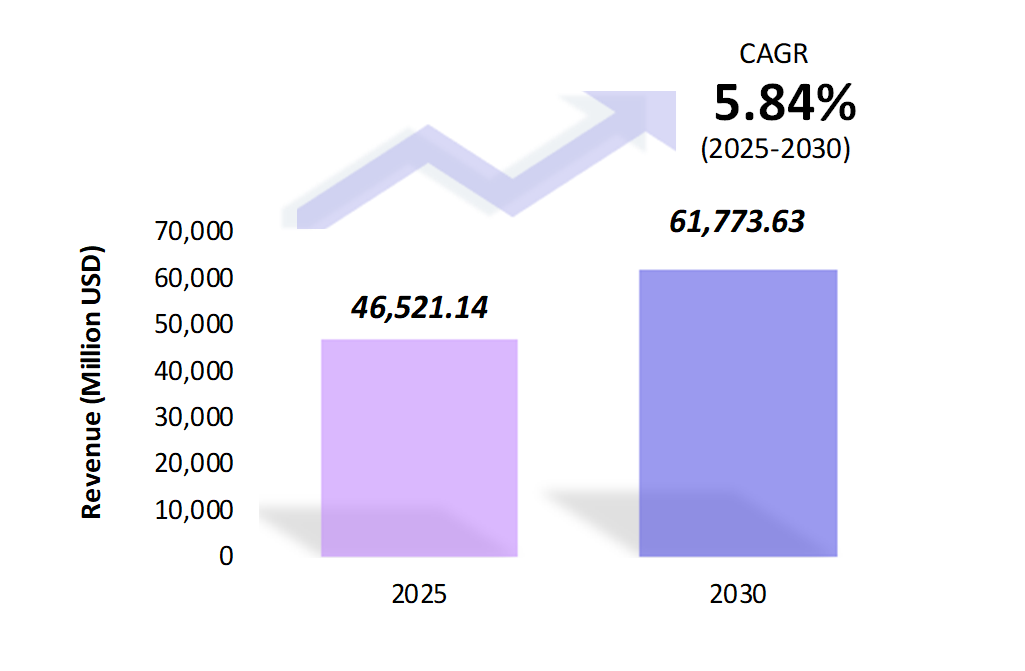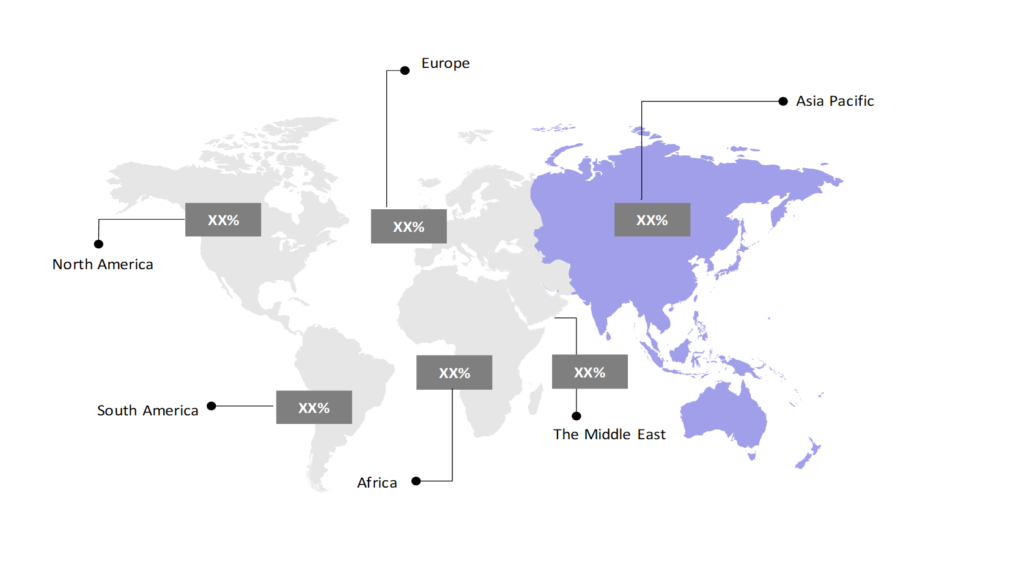Copper Tubes Market Outlook: Size, Share, Trends & Growth Analysis (2024-2029)
The market report presents a thorough analysis segmented by Type (Straight Lengths, Coils, Pancake or Flattened Tubes, U-Bends, Drawn Tubes, Others); by Application (Plumbing, HVACR, Industrial, Medical Gas System, Fire Sprinkler System, Automotive, Others); by Geography (North America, South America, Asia Pacific, Europe, The Middle East, Africa).
Outlook

- The copper tubes market is estimated to be at USD 46,521.14 Mn in 2025 and is anticipated to reach USD 61,773.63 Mn in 2030.
- The copper tubes market is registering a CAGR of 5.84% during the forecast period 2025-2030.
- The global copper tubes market is steadily growing, driven by increasing demand from sectors like construction, HVAC, plumbing, and industrial applications. The material’s superior thermal conductivity, durability, and corrosion resistance make it essential for heat exchange systems and fluid transfer.
Request a free sample.
Ecosystem

- The global copper tubes industry participants are continuously developing strategies to preserve a competitive advantage.
- These companies primarily use acquisitions, innovations, partnerships, and technological launches.
- Several important entities in the copper tubes market include Mueller Industries, Inc.; KME Group S.p.A; Wieland Group; KOBELCO Group; Shanghai Metal Corp.; and others.
Ask for customization.
Findings
| Attributes | Values |
|---|---|
| Historical Period | 2019-2023 |
| Base Year | 2024 |
| Forecast Period | 2025-2030 |
| Market Size (2025) | USD 46,521.14 Mn |
| Market Size (2030) | USD 61,773.63 Mn |
| Growth Rate | 5.84% CAGR from 2025 to 2030 |
| Key Segments | Type (Straight Lengths, Coils, Pancake or Flattened Tubes, U-Bends, Drawn Tubes, Others); Application (Plumbing, HVACR, Industrial, Medical Gas System, Fire Sprinkler System, Automotive, Others); Geography (North America, South America, Asia Pacific, Europe, The Middle East, Africa) |
| Key Vendors | Mueller Industries, Inc.; KME Group S.p.A; Wieland Group; KOBELCO Group; Shanghai Metal Corp. |
| Key Countries | The US; Canada; Mexico; Brazil; Argentina; Colombia; China; India; Japan; The UK; Germany; UAE; Saudi Arabia; Egypt; South Africa |
| Largest Market | Asia Pacific |
Get a free quote.
Trends
- Shift Toward Lightweight Materials in Industries: Many industries, particularly automotive and aerospace, opt for copper tubes due to their balance between lightweight properties and high strength. This shift is supported by the increasing emphasis on fuel-efficient and environmentally friendly vehicles. Copper’s malleability and recyclability make it suitable for such evolving industrial needs.
- Innovations in Tube Manufacturing: Advanced manufacturing processes such as continuous extrusion and seamless tube production make copper tubes more durable and efficient. Innovations in tube design are helping manufacturers create more cost-effective, reliable, and high-performing products for various applications.
- Focus on Sustainable Copper Recycling Practices: Copper’s recyclability is becoming a focal point for manufacturers as sustainability becomes a priority across industries. Initiatives for the circular economy, such as closed-loop recycling systems, are gaining traction. In 2022, Aurubis AG introduced new recycling programs to reclaim copper from waste products, reducing the need for virgin copper mining.
Speak to analyst.
Catalysts
- Growing HVAC and Refrigeration Industry: The demand for copper tubes is closely tied to the growth of the Heating, Ventilation, and Air Conditioning (HVAC) and refrigeration industries. As global temperatures rise and the need for climate control increases, copper tubes are preferred for their superior heat transfer properties.
- Rise of the Automotive Industry: Copper tubes are widely used in automotive heat exchange systems, such as radiators and cooling systems. The demand for copper tubes is increasing with the automotive industry’s shift toward electric vehicles (EVs), which require efficient thermal management.
- Government Initiatives for Energy Efficiency: Governments worldwide promote energy-efficient technologies, which often involve copper-based components due to their superior conductivity and sustainability. In 2022, the US government passed new regulations for energy efficiency in buildings, increasing the use of copper tubes in HVAC systems and plumbing.
Inquire before buying.
Restraints
- Fluctuations in Copper Prices: The copper market experiences price volatility due to global supply chain disruptions, stringent mining regulations, and geopolitical tensions. Trade disputes or natural disasters can disrupt supply, while environmental regulations may limit production capacity. Additionally, geopolitical conflicts hinder exports, creating uncertainty that affects industries reliant on copper, such as electronics and construction.
- Technological Barriers in Recycling: While copper recycling is an attractive option for sustainability, refining recycled copper to the quality required for high-performance applications like Heating, Ventilation, and Air Conditioning (HVAC) systems and medical use presents technological challenges.
- Environmental Regulations: The copper industry faces strict environmental regulations, particularly related to mining and smelting processes, which can limit production capacity. In 2023, new EU regulations targeting carbon emissions in industrial production added pressure on copper producers to adopt greener practices, which can increase operational costs.
Personalize this research.
Hotspot

Explore purchase options.
Table of Contents
| 1. Introduction 1.1. Research Methodology 1.2. Scope of the Study 2. Market Overview / Executive Summary 2.1. Global Copper Tubes Market (2019 – 2023) 2.2. Global Copper Tubes Market (2024 – 2030) 3. Market Segmentation 3.1. Global Copper Tubes Market by Type 3.1.1. Straight Lengths 3.1.2. Coils 3.1.3. Pancake or Flattened Tubes 3.1.4. U-Bends 3.1.5. Drawn Tubes 3.1.6. Others 3.2. Global Copper Tubes Market by Application 3.2.1. Plumbing 3.2.2. HVACR 3.2.3. Industrial 3.2.4. Medical Gas System 3.2.5. Fire Sprinkler System 3.2.6. Automotive 3.2.7. Others 4. Regional Segmentation 4.1. North America 4.1.1. The US 4.1.2. Canada 4.1.3. Mexico 4.2. South America 4.2.1. Brazil 4.2.2. Argentina 4.2.3. Chile 4.2.4. Rest of South America 4.3. Asia Pacific 4.3.1. China 4.3.2. India 4.3.3. Japan 4.3.4. Rest of Asia Pacific 4.4. Europe 4.4.1. The UK 4.4.2. Germany 4.4.3. Rest of Europe 4.5. The Middle East 4.5.1. UAE 4.5.2. Saudi Arabia 4.5.3. Rest of the Middle East 4.6. Africa 4.6.1. Egypt 4.6.2. South Africa 4.6.3. Rest of Africa 5. Value Chain Analysis of the Global Copper Tubes Market 6. Porter Five Forces Analysis 6.1. Threats of New Entrants 6.2. Threats of Substitutes 6.3. Bargaining Power of Buyers 6.4. Bargaining Power of Suppliers 6.5. Competition in the Industry 7. Trends, Drivers and Challenges Analysis 7.1. Market Trends 7.1.1. Market Trend 1 7.1.2. Market Trend 2 7.1.3. Market Trend 3 7.2. Market Drivers 7.2.1. Market Driver 1 7.2.2. Market Driver 2 7.2.3. Market Driver 3 7.3. Market Challenges 7.3.1. Market Challenge 1 7.3.2. Market Challenge 2 7.3.3. Market Challenge 3 8. Opportunities Analysis 8.1. Market Opportunity 1 8.2. Market Opportunity 2 8.3. Market Opportunity 3 9. Competitive Landscape 9.1. Mueller Industries, Inc. 9.2. KME Group S.p.A 9.3. Wieland Group 9.4. KOBELCO Group 9.5. Shanghai Metal Corp. 9.6. Company 6 9.7. Company 7 9.8. Company 8 9.9. Company 9 9.10. Company 10 |
Know the research methodology.
Copper Tubes Market – FAQs
1. What is the current size of the copper tubes market?
Ans. In 2025, the copper tubes market size is USD 46,521.14 Mn.
2. Who are the major vendors in the copper tubes market?
Ans. The major vendors in the copper tubes market are Mueller Industries, Inc.; KME Group S.p.A; Wieland Group; KOBELCO Group; Shanghai Metal Corp.
3. Which segments are covered under the copper tubes market segments analysis?
Ans. The copper tubes market report offers in-depth insights into Type, Application, and Geography.
